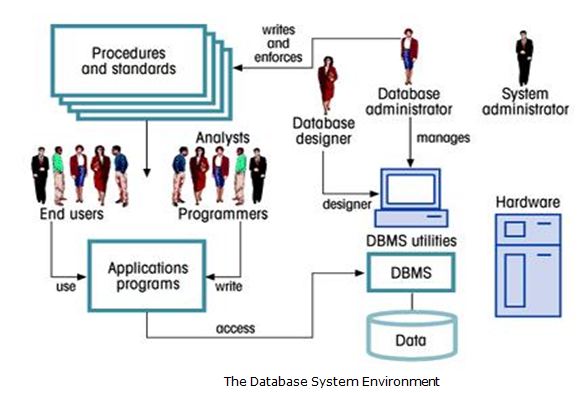The term database system refers to an organization of components that define and regulate the collection, storage, management, and use of data within a database environment.
The five major components of database management system are
Hardware,
Software,
People,
Procedures, and
Data.

Components of Database Management System(DBMS) with diagram
1. Components of Database Management System: Hardware
Hardware is the one of the most important component of dbms system. It refers to all of the system’s physical devices like computers (PCs, workstations, servers, and supercomputers), storage devices, printers, network devices (hubs, switches, routers, fiber optics),and other devices (automated teller machines, ID readers, and so on).
2. Components of Database Management System: Software
Although the most readily identified software is the DBMS itself, to make the database system function fully, three types of software are needed: operating system software, DBMS software, and application programs and utilities.
a. Operating system software:
It manages all hardware components and makes it possible for all other software to run on the computers. Examples of operating system software include Microsoft Windows, Linux, MacOS, UNIX, and MVS.
b. DBMS software:
It manages the database within the database system. Some examples of DBMS software include Microsoft’s SQL Server, Oracle Corporation’s Oracle, Sun’s MySQL, and IBM’s DB2.
c. Application programs and utility software:
These are used to access and manipulate data in the DBMS and to manage the computer environment in which data access and manipulation take place. Application programs are most commonly used to access data found within the database to generate reports, tabulations, and other information to facilitate decision making. Utilities are the software tools used to help manage the database system’s computer components. For example, all of the major DBMS vendors now provide graphical user interfaces (GUIs) to help create database structures, control database access, and monitor database operations.
3. Components of Database Management System: dbms users
This component includes all DBMS users. On the basis of primary job functions, five types of users can be identified in a database system: system administrators, database administrators, database designers, system analysts and programmers, and end users. Each user type, described below, performs both unique and complementary functions.
-System administrators oversee the database system’s general operations.
-Database administrators, also known as DBAs, manage the DBMS and ensure that the database is functioning properly.
-Database designers design the database structure. They are, in effect, the database architects. If the database design is poor, even the best application programmers and the most dedicated DBAs cannot produce a useful database environment. Because organizations strive to optimize their data resources, the database designer’s job description has expanded to cover new dimensions and growing responsibilities.
-System analysts and programmers design and implement the application programs. They design and create the data entry screens, reports, and procedures through which end users access and manipulate the database’s data.
-End users are the people who use the application programs to run the organization’s daily operations. For example, salesclerks, supervisors, managers, and directors are all classified as end users. High-level end users employ the information obtained from the database to make tactical and strategic business decisions.
4. Components of Database Management System : Procedures
Procedures are the instructions and rules that govern the design and use of the database system. Procedures are another important component of the dbms system. Procedures play an important role in a company because they enforce the standards by which business is conducted within the organization and with customers. Procedures are also used to ensure that there is an organized way to monitor and audit both the data that enter the database and the information that is generated through the use of those data.
5. Components of Database Management System : Data
The word data covers the collection of facts stored in the database. Because data are the raw material from which information is generated, the determination of what data are to be entered into the database and how those data are to be organized is a vital part of the database designer’s job.
You may also like: Problems With Traditional File Processing System
Different Advantages and Disadvantages of DBMS
Other Database Systems Questions




